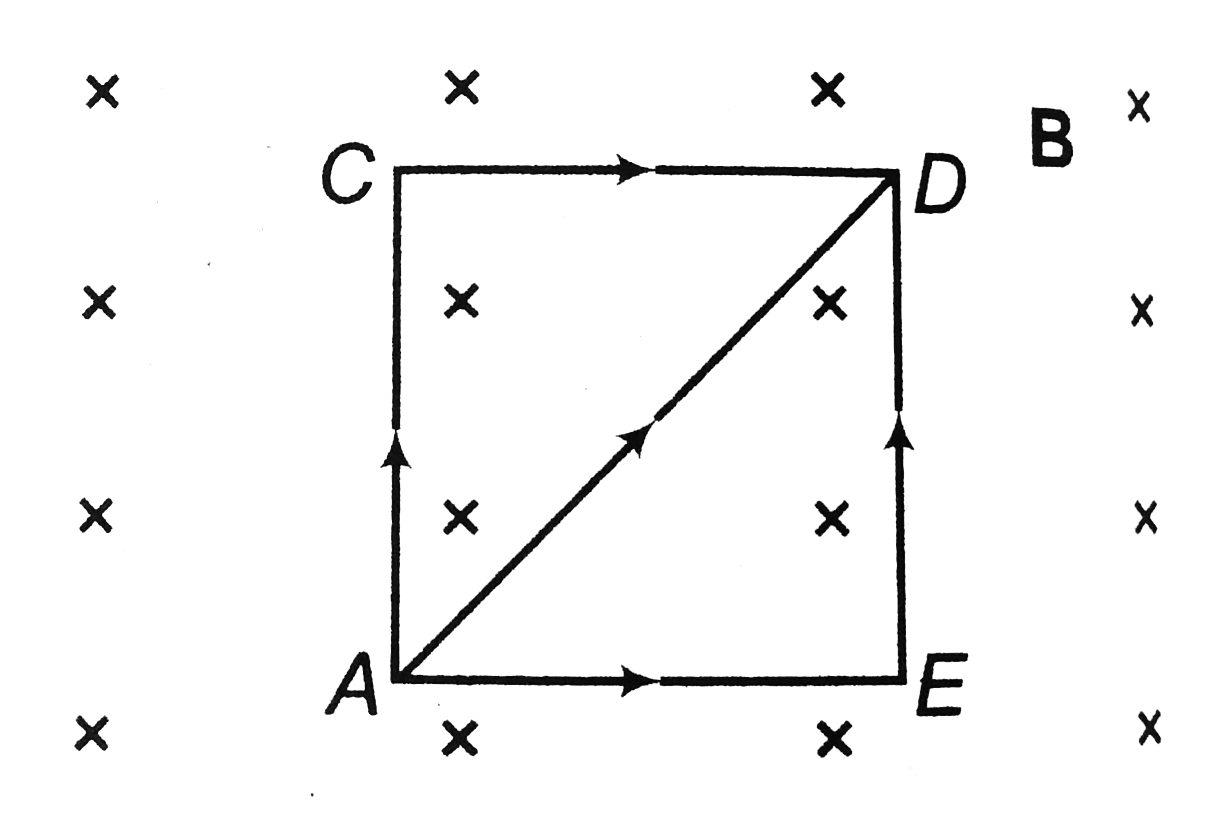A conducting square loop having edges of length2.0 cm is rotated through 180∘ about a diagonal in 0.20s. A magnetic field B exists in the region which si perpendicular to the loop in its initial position. If the average induced emf during the rotation is 20 mV, find the magnitude of the magnetic field.
To solve the problem step by step, we will follow the principles of electromagnetic induction and the relevant formulas.
Step 1: Identify the given values
- Length of the square loop, L=2.0cm=0.02m
- Area of the square loop, A=L2=(0.02m)2=4×10−4m2
- Time taken for rotation, dt=0.20s
- Average induced emf, E=20mV=20×10−3V
- The change in angle, Δθ=180∘
Step 2: Calculate the change in magnetic flux
The magnetic flux Φ through the loop is given by:
Φ=B⋅A⋅cos(θ)
- Initially, when the loop is in its original position, θ=0∘:
Φ1=B⋅A⋅cos(0)=B⋅A
- After rotation through 180∘, θ=180∘:
Φ2=B⋅A⋅cos(180)=−B⋅A
- The change in magnetic flux ΔΦ is:
ΔΦ=Φ2−Φ1=−B⋅A−B⋅A=−2B⋅A
Step 3: Relate induced emf to the change in magnetic flux
According to Faraday's law of electromagnetic induction, the induced emf E is given by:
E=−ΔΦdt
Substituting the expression for ΔΦ:
E=−−2B⋅Adt=2B⋅Adt
Step 4: Rearranging the equation to find B
Now, we can rearrange the equation to solve for B:
B=E⋅dt2A
Step 5: Substitute the known values
Substituting the values we have:
B=(20×10−3V)⋅(0.20s)2⋅(4×10−4m2)
Step 6: Calculate B
Calculating the numerator:
20×10−3⋅0.20=4×10−3
Calculating the denominator:
2⋅4×10−4=8×10−4
Now, substituting these values:
B=4×10−38×10−4=48×101=0.5T=5T
Final Answer
The magnitude of the magnetic field B is 5T.
---
- Length of the square loop, L=2.0cm=0.02m
- Area of the square loop, A=L2=(0.02m)2=4×10−4m2
- Time taken for rotation, dt=0.20s
- Average induced emf, E=20mV=20×10−3V
- The change in angle, Δθ=180∘
The magnetic flux Φ through the loop is given by:
Φ=B⋅A⋅cos(θ)
- Initially, when the loop is in its original position, θ=0∘:
Φ1=B⋅A⋅cos(0)=B⋅A
- After rotation through 180∘, θ=180∘:
Φ2=B⋅A⋅cos(180)=−B⋅A
- The change in magnetic flux ΔΦ is:
ΔΦ=Φ2−Φ1=−B⋅A−B⋅A=−2B⋅A
According to Faraday's law of electromagnetic induction, the induced emf E is given by:
E=−ΔΦdt
Substituting the expression for ΔΦ:
E=−−2B⋅Adt=2B⋅Adt
Now, we can rearrange the equation to solve for B:
B=E⋅dt2A
Substituting the values we have:
B=(20×10−3V)⋅(0.20s)2⋅(4×10−4m2)
Calculating the numerator:
20×10−3⋅0.20=4×10−3
Calculating the denominator:
2⋅4×10−4=8×10−4
Now, substituting these values:
B=4×10−38×10−4=48×101=0.5T=5T
The magnitude of the magnetic field B is 5T.
Topper's Solved these Questions
- ELECTROMAGNETIC INDUCTIONBOOK - HC VERMA ENGLISHCHAPTER - ELECTROMAGNETIC INDUCTIONEXERCISE - Questions for short answer
9 Videos
- ELECTROMAGNETIC INDUCTIONBOOK - HC VERMA ENGLISHCHAPTER - ELECTROMAGNETIC INDUCTIONEXERCISE - Objective 2
10 Videos
- ELECTRIC FIELD AND POTENTIALBOOK - HC VERMA ENGLISHCHAPTER - ELECTRIC FIELD AND POTENTIALEXERCISE - Objective 2
7 Videos
- ELECTROMAGNETIC WAVESBOOK - HC VERMA ENGLISHCHAPTER - ELECTROMAGNETIC WAVESEXERCISE - Exercise
8 Videos
Similar Questions
A wire loop confined in a plane is rotated in its open plane with some angular velocity. A uniform magnetic field exists in the region. Find the emf induced in the loop.
View SolutionA conducting loop confined in a plane is rotated in its own plane with some angular velocity.A uniform and constant magnetic field exist in the region.Find the current induced in the loop.
View SolutionA copper rod of length 2m is rotated with a speed of 10 rps, in a uniform magnetic field of 1 tesla about a pivot at one end. The magnetic field is perpendicular to the plane of rotation. Find the emf induced across its ends
View SolutionThe graph shows the variation of magnetic field B that exists through a conducing loop, perpendicular to the plane of the loop. The emf's induced in the loop during equal intervals a, b, c, d and e are related as
View SolutionA square of side 2.0m is placed in a uniform magnetic field B=2.0T in a direction perpendicular to the plane of the square inwards. Equal current i=3.0A is flowing in the directions shown in figure. Find the magnitude of magnetic force on the loop.

View SolutionA square of side 2.0m is placed in a uniform magnetic field B=2.0T in a direction perpendicular to the plane of the square inwards. Equal current i=3.0A is flowing in the directions shown in figure. Find the magnitude of magnetic force on the loop.

View SolutionA conducting rod OA of length l is rotated about its end O with an angular velocity ω in a uniform magnetic field directed perpendicualr to the rotation. Find the emf induced in the rod, between it's ends.
View SolutionA conducting circular loop of radius r is rotated about its diameter at a constant angular velocity ω in a magnetic field B perpendicular to the axis of rotation. In what position of the loop is the induced emf zero?
View SolutionA conducintg circular loop having a redius of 5.0cm, is placed perpendicular to a magnetic field of 0.50 T. It is removed from the field in 0.50 s. Find the average emf produced In the loop during this time.
View SolutionA conducting square loop is placed in a magnetic field B with its plane perpendicular to the field. Now the sides of the loop start shrinking at a constant rate α. the induced emf in the loop at an instant when its side is a is
View Solution
